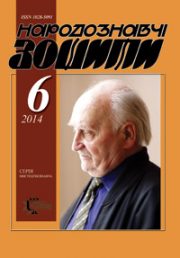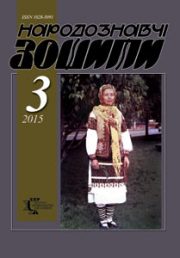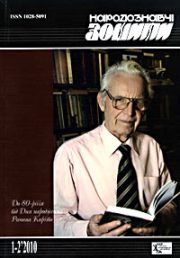The Ethnology Notebooks. 2021. # 2 (158), P. 456—471
УДК 398.22+81:[394.262:64+46/392.81]
DOI https://doi.org/10.15407/nz2021.02.456
Iryna KOVAL-FUCHYLO
ORCID ID: https://orcid.org/0000-0003-4048-914
- Dr. Philology, Older Scientific Worker,
- Rylsky Institute for Art Studies,
- Folklore and Ethnology,
- Ukrainian National Academy of Sciences,
- 4, Hrushevskoho str., 01001, Kyiv, Ukraine,
- e-mail: koval-fuchylo@ukr.net
MEMORIAL CULTURE AND ORAL STORIES ABOUT RELOCATION FROM FLOOD ZONES
The article analyses the main commemorative practices dedicated to flooded settlements in Ukraine, activities aimed at archiving, conservation, promotion of information about these villages. The main material of the study is typical fragments of stories about forced relocation from the flood zone, namely stories about annual meetings of migrants from one village, former fellow villagers, publication of books about flooded villages, the creation of a museum devoted to flooded villages. Meetings of migrants are the most common social form of preserving the cultural memory about flooded zones. The action and subject lines in these memorial practices are described, namely collective meals, hymns, photography. The described forms of cultural memory preservation are components of Ukraine modern memorial culture.
The purpose of the article is to describe the action and subject code of these memorial practices, namely joint meals, hymns, photography, as well as to describe other forms of cultural memory preservation, namely books about flooded villages, a public initiative to create a museum of flooded villages. The described forms of cultural memory preservation are components of Ukraine modern memorial culture. Chronological boundaries of the study — 1960—2019. General (observation, comparison) and special (interviews, comparative-historical, structural, textual analysis) research methods were used. The main source material is interviews recorded and deciphered by the author during 2012—2019 with migrants from flooded villages.
The facts that the story about the commemoration becomes part of a personal memory, indicate that the memorial events mentioned have already become part of the social and cultural memory of the social group of migrants. These stories have already undergone a significant folklorization, which consists in the similarity and a certain phrases pattern and structural parts of the text: first they tell about the date of the meeting, then about its place, then about leaving for the Dnipro and a common party. The presence of migrants meetings photos in the books about flooded villages, the existence of stories about these meetings in the people memories suggest that history is already the actual meeting of migrants, and these events to some extent «displace» the memory about resettlement and flooding.
Keywords: oral history, forced relocation, flooded village, memorial culture, anthem, towel, museum.
REFERENCES
- Assman, A. (2014). The Long Shadow of the Past: Memorial Culture and Historical Politics. Moskva: Novoe lyteraturnoe obozrenye [in Russian].
- Assman, A. (2016). New dissatisfaction with the memorial culture. Moskva: Novoe lyteraturnoe obozrenye [in Russian].
- Horbnyak, T. (2020). The alphabet of Bakota inhabitant. Kamyanets’-Podil’s’kyy: Aksioma [in Ukrainian].
- Horbnyak, T. (2004). Bakota. Warmed destiny. Khmel’nyts’kyi: Podillya [in Ukrainian].
- Horbnyak, T. (2013). Old Bakota. Kamyanets’-Podil’s’kyi: Medobory-2006» [in Ukrainian].
- Horbnyak, T. (2018). Bakota Trails. Kamyanets’-Podil’s’kyi: Aksioma [in Ukrainian].
- Mykhnyak, M. (Ed.). (2018). Flooded Paradise: Andrushi in Memoirs and Documents. Kyiv: Ukrayins’kyi priorytet [in Ukrainian].
- Kuz’menko-Lisovenko, K. (2018). Flooded Dnipro civilization. History. Human destinies. Kyiv: Interkontynental[in Ukrainian].
- Lesyk, M. (2007). Tsibli is my native village in the Pereyaslav region (Memories). Pereyaslav-Khmel’nytskyi: SKD[in Ukrainian].
- Mykhnyak, M. (2020). There were Trakhtemyriv and Monastyrok over the Dnipro. Documents, memories, photos. Kyiv: Ukrayins’kyi priorytet[in Ukrainian].
- Mykhnyak, M., & Zuber, S. (Eds.). (2019). We now only dream of Pidsinne. The village in memories and documents.Kyiv: Ukrayins’kyi priorytet[in Ukrainian].
- Skrypnyk, H. (Ed.). (2016). The village of Andrushi in the Pereyaslav region. Historical and ethnographic essay. Kyiv: NAN Ukrainy; IMFE [in Ukrainian].
- Sorokova, S., Nahajko, T., & Horbovyj, O. (Eds.). (2015). Swallows do not fly in Zarubynci: historical and local lore essay. Pereyaslav-Khmel’nytskyi. Retrieved from: http://ephsheir.phdpu.edu.ua/xmlui/handle/8989898989/829 [in Ukrainian].
- Valentsova, M., & Uzn’ova, E. (1999). Meal. In Slavic Antiquities: Ethnolinguistic Dictionary: in 5 v. (Vol. 5, pp. 307—312). Moskva [in Russian].
- Nud’ha, H. (Ed.). (1960). Songs and romances of Ukrainian Soviet poets 1917—1957. 1917—1957. Kyiv: Radyans’kyj pys’mennyk [in Ukrainian].
- Lobko, V. (Ed.). (1982). Songs of the Great Patriotic War. For vocal ensembles accompanied by banduras. Kyiv: Muzychna Ukrajina [in Ukrainian].
- Min’kivs’kyi, O. (1967). Songs of struggle and freedom. Kyiv: Mystetstvo [in Ukrainian].
- (2020). Ukrainian songs-1. Retrieved from: https://www.pisni.org.ua/songs/9283889.html#songsfiles (accessed 9.09.2020) [in Ukrainian].
- (2020). Ukrainian songs-2. Retrieved from: https://www.pisni.org.ua/users/38730.html (accessed 9 September 2020) [in Ukrainian].
- Koval-Fuchylo, I. (2020). Lost place in the memories of forced resettlement and in social practices. Folklor Study, Serbian scientific magazine, 5 (1), 73—88 [in Russian].
- Nahayko, T. (Ed.). (2015). «Chronicle of the Zarubynci family». In Sorokova, S. Swallows do not fly in Zarubynci: historical and local lore essay (Pp. 4—5). Pereyaslav-Khmel’nytskyi [in Ukrainian].
- Ivashchenko, V. (2020). Public organization «Old Dnipro» at the sports and cultural event «Dnipro-roaring 2020». Retrieved from: http://olddnieper.org.ua/news/item/138-ho-staryi-dnipro-na-sportyvnokulturolohichnomu-zakhodi-dniprorevuchyi-2020 (accessed 4.12.2020) [in Ukrainian].
- Ivashchenko, V. (2019). Swim «Dnipro roaring-2019». Retrieved from: http://olddnieper.org.ua (accessed 29.12.2020) [in Ukrainian].
- Ivashchenko, V. (2020). Creation a museum of Kaniv Reservoir flooded villages. Retrieved from: http://olddnieper.org.ua/news/item/95-stvorennia-muzeiu-zatoplenykh-sil-pereiaslavshchyny (accessed: 9.12.2020) [in Ukrainian].
- Assman, A. (2014) Spaces of memory. Forms and transformations of cultural memory. Kyiv: Nika-Tsentr [in Ukrainian].







